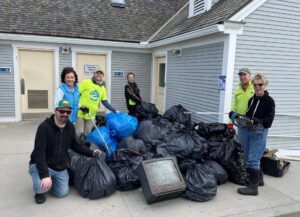 HYANNIS – A new heart device available on Cape Cod may allow some patients with a persistent and dangerous type of heart arrhythmia to give up blood thinners, without increasing their risk of stroke.
HYANNIS – A new heart device available on Cape Cod may allow some patients with a persistent and dangerous type of heart arrhythmia to give up blood thinners, without increasing their risk of stroke.
The “Watchman” device works like a small umbrella and is about the size of a quarter. Doctors insert it in the heart to keep blood clots from forming and entering the rest of the body, causing strokes.
It was approved by the U.S. Food and Drug Administration in March 2015 for patients who have an arrhythmia known as “atrial fibrillation,”or “AFib,” that is not related to issues with their heart valves.
“I think it will be widespread; I think it’s a very attractive alternative to taking oral anticoagulants,” said Peter Friedman MD, PhD, FACC, FHRS, a Cape Cod Healthcare cardio-electrophysiologist who has so far done two Watchman implants at Cape Cod Hospital (CCH).
“It’s been approved in certain patient groups but not for everybody. That will depend on the results of the newer trials but I think data presented to the FDA from the clinical trials clearly demonstrated the benefits of this device,” he said.
In a normally functioning heart, the sinus node acts as the pacemaker, sending off electrical impulses through the atria (the heart’s upper chambers) into the ventricles (the lower chambers), telling them to contract and pump blood throughout the body. AFib occurs when the electrical impulses fire independently of each other, causing a chaotic heart rhythm, according to Dr. Friedman. That can cause the heart to quiver instead of contract, allowing the blood to pool in nooks and crannies, particularly in a small sack off the left atrium called the left atrial appendage or LAA.
The LAA is where many problems start. It’s small – about a half-inch to 2 inches long – but it’s a common site for blood to collect and form clots, which can travel to the brain and cause a stroke.
“It’s estimated in patients whose AFib is not related to a valve problem, that 90 percent of strokes are related to the LAA,” Dr. Friedman said.
First Cape Patient
David Howes, 76, of East Dennis, knows the condition well. Dr. Friedman treated his AFib with an ablation procedure (inserting a catheter into the heart and using radio waves to destroy the misfiring tissue) a few years ago, but the condition returned and he was again prescribed an anti-coagulant to lower the chance of a stroke.
When the Watchman procedure became available on Cape Cod last year, he was the first patient to receive the implant. Dr. Friedman suggested it and Howes decided to go for it. He had the surgery in June and said he was off blood thinners by the fall.
“When you ask your doc, ‘how many have you done?’ and he says, ‘you’ll be the first,’ you better have some confidence in the guy,” said Howes, a former merchant mariner and charter fishing boat captain, who now runs a mooring service.
“There was no pain, no strain, never felt a thing,” Howes said. He also was reassured when he met the surgical team. “They were a sharp bunch, the whole bunch of them,” he said.
Howes said he was “delighted” to be off the blood thinner medication, and now takes only an aspirin a day and another drug to regulate his heartbeat.
A Unique Solution
Until now, the most common solution for patients with AFib was to take blood anti-coagulants, like warfarin (the generic name of Coumadin). Ablation was another option. But patients undergoing ablation may still require anti-coagulant medications, which have their own issues such as bruising, nosebleeds, gastrointestinal bleeds and even stroke if incorrectly dosed. They can also be expensive or require blood tests that may not always be reimbursable by insurance, according to Dr. Friedman.
Instead, the Watchman implant seals off the atria from the LAA so blood can’t pool in the pouch. The process usually takes less than an hour under general anesthesia, Dr. Friedman said. Working with a team that includes CCH interventional cardiologist Richard Zelman, MD, FACC and a cardiac anesthesiologist, Dr. Friedman uses a catheter to travel through an incision in the upper leg, through the vascular system, into the left atrium.
The Watchman is then detached from the tip of the catheter and opens like an umbrella, creating a dam to block blood from passing into the LAA. Eventually, heart tissue grows over the device, permanently sealing off the LAA, according to a video on the Watchman website.
Patients usually stay in the hospital for 24 hours, Dr. Friedman said. If all goes well, they may be off blood thinners in as early as 45 days, he said.
Overwhelmingly Successful
The Watchman has been available in Europe since about 2005. It was approved here in the U.S. after the FDA found it to be “non-inferior” to warfarin in preventing stroke, systemic embolism or cardiovascular death. A survey of Watchman implants reported in the Journal of American College of Cardiology this year, found that of the 3,822 completed in the United States following FDA approval, 3,653 were successful – or 95.6 percent.
The survey found that complication risks in the first year of widespread use were even lower than the rates reported in clinical trials of the Watchman, even though it was a new device to many physicians.
While the Watchman offers some patients an alternative to blood thinners, it is not the first-line treatment for everyone, Dr. Friedman said.
“Right now, it’s reserved for patients who need an anti-coagulant but have a compelling reason why oral anticoagulants are not a good idea.”
Also, Medicare has specific guidelines for patients to be eligible for Watchman procedures and there is not universal coverage yet by private insurance, he said.























